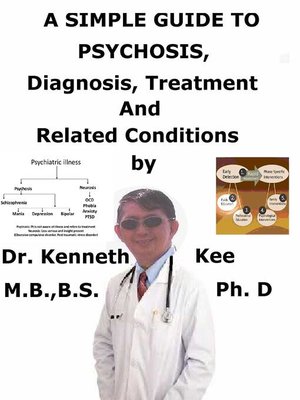
Sign up to save your library
With an OverDrive account, you can save your favorite libraries for at-a-glance information about availability. Find out more about OverDrive accounts.
Find this title in Libby, the library reading app by OverDrive.



Search for a digital library with this title
Title found at these libraries:
| Library Name | Distance |
|---|---|
| Loading... |
This book describes Psychosis, Diagnosis and Treatment and Related Diseases
There was a time when the psychiatric world recognize 2 main illness: neurosis and psychosis
Since 1980 Neurosis has been removed as a single disorder by the Diagnostic and Statistical Manual of Mental Disorders (DSM III) and placed together with other anxiety disorders.
It is still utilized in the ICD-10 F48.9 (Non-psychotic mental disorder, unspecified)
Psychosis is placed under the Disorder Class in DSMV: Schizophrenia Spectrum and Other Psychotic Disorders
Under the ICD-10 it is placed under 2021 ICD-10-CM Diagnosis Code F29
(Unspecified psychosis not due to a substance or known physiological condition)
Psychosis is a symptom of loss of contact with reality, normally including delusions (false ideas about what is taking place or who the person is) and hallucinations (seeing or hearing things that are not there).
It affects the way that the brain interprets information.
When having psychosis, people may hear, see, feel, or believe things that are not real.
Psychosis is featured by an impaired relationship with reality.
People who are having psychosis may have either hallucinations or delusions.
Hallucinations are sensory experiences that happen within the absence of an actual stimulus.
A person having an auditory hallucination may hear their mother yelling at them when their mother is not around.
Someone having a visual hallucination may see something, like a person in front of them, who is not really there.
The person having psychosis may also have thoughts that are different from actual evidence.
These thoughts are termed delusions.
Some people with psychosis may also develop loss of motivation and social withdrawal.
These delusions and hallucinations can be frightening.
They may also cause people who are having psychosis to hurt themselves or others.
It is important to consult a doctor right away if a person is having symptoms of psychosis.
About 7 in every 1000 people have psychosis at some time in their lives but not everyone experiences psychosis the same way.
There are many types of psychosis and several disorders and incidents that can lead to it.
Psychosis is not a disorder on its own.
It is really a symptom that is evident in a range of mental health disorders, or it can happen as a reaction to brain changes, traumatic events, injuries, or substance use.
These disruptive thoughts and sensory experiences cause a disconnection from reality and a struggle in differentiating what is real from what is not.
The precise causes of psychosis are not totally clear and each person's experience may be different.
Physical problems that can cause psychosis are:
1. Alcohol and certain illicit drugs, including methamphetamine
2. Brain cysts or tumors
3. Certain prescription medicines, specifically steroids and stimulants
4. Certain types of epilepsy
5. Dementia
6. HIV
7. Parkinson's disease
8. Stroke
Psychosis can also be caused by a mental health disorder such as:
1. Schizophrenia,
2. Schizoaffective disorder,
3. Bipolar disorder,
4. Depression
People are more likely to develop psychosis if they also have a close family member, such as a parent or sibling, who has a history of psychotic disorder.
There are also triggers such as:
1. Drug use,
2. Lack of sleep, and
3. Other environmental factors and settings can cause specific types of psychosis developing.
The main symptoms of psychosis are delusions and hallucinations.
TABLE OF...







